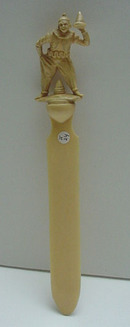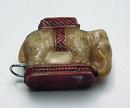VICTORIAN BULLDOG CANE / CELLULOID/ COCOBOLO




$500.00
This engaging Victorian bulldog walking stick was made of Celluloid, an early plastic that became a cheap and versatile replacement for ivory beginning as early as the 1850s and 1860s. The figural dog's head is realistically carved and measures 2-1/2 by 2 inches. His pleasant expression and glass eyes make him all the more appealing. The cocobolo shaft terminates in a horn tip. Overall length of this charming stick is 35 inches. He is not snarling. He just patiently awaits your next command. Very good condition. *** Celluloid was extremely useful for creating cheaper jewelry, jewelry boxes, hair accessories and many items that would earlier have been manufactured from ivory, horn or other expensive animal products. Consequently it was often referred to as "Ivorine" or "French Ivory". It was also used for dressing table sets, dolls, picture frames, charms, hat pins, buttons, buckles, the false fronts of shirts known as 'dickies", stringed instrument parts, accordions, cutlery handles and kitchen items. The main disadvantage the material had was that it was flammable and fragile. Items made of Celluloid are collectible today and increasingly rare when in good condition like this walking stick. Celluloid was eventually replaced with Bakelite. Besides being fabricated into jewelry and trinkets, dental pieces, false shirt fronts called “dickies,” in 1900 it was made into strip format for movie film. *** The first celluloid as a bulk material for forming objects was made in 1855 in Birmingham, England, by Alexander Parkes, who never saw his invention reach full fruition, after his firm went bankrupt due to scale-up costs. Parkes patented his discovery after realizing a solid residue remained after evaporation of the solvent from the photographic material collodion. Parkes patented it as a clothing waterproof for woven fabrics in the same year. Later in 1862, he showcased Parkesine at the Great Exhibition in London, where he was awarded a bronze medal for his efforts. The introduction of Parkesine is generally regarded as the birth of the plastics industry. Parkes mixed cellulose nitrate with camphor, producing a hard, flexible, and transparent material. Cellulose nitrate was dissolved in a small measure of solvent, this was then heated and rolled on a purpose-built machine which extracted a proportion of the solvent. Finally, the use of pressure or dyes completed the manufacturing process. Generally regarded to be the first thermoplastic, it was first created as Parkesine in 1862 and as Xylonite in 1869, before being registered as Celluloid in 1870. Celluloid is easily molded and shaped, and it was first widely used as an ivory replacement. A thermoplastic is a polymer that turns to a liquid when heated and freezes to a very glassy state when cooled sufficiently. Celluloid's most common uses today are in table tennis balls and guitar picks.






